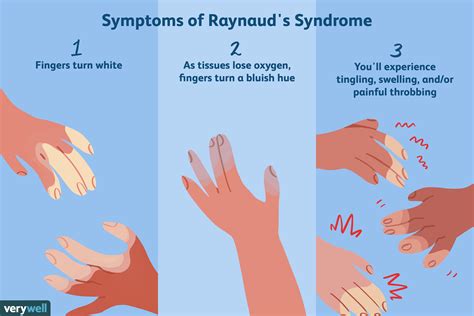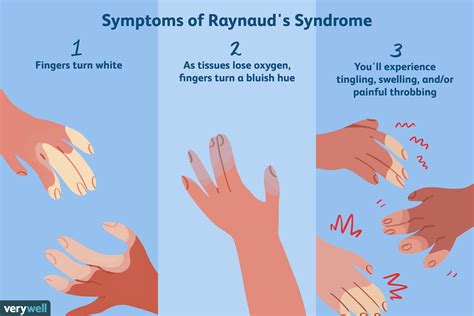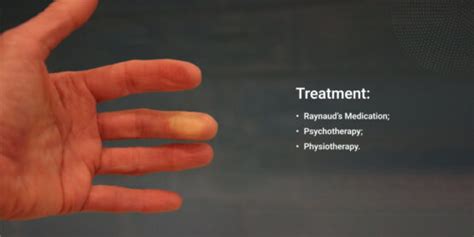Intro
Discover Raynauds Disease symptoms, including finger discoloration, numbness, and pain. Learn about triggers, diagnosis, and treatment options for this vascular condition, characterized by poor blood circulation and vasospasm episodes.
Raynaud's disease is a condition that affects blood flow to the fingers and toes, and sometimes the ears, nose, and lips. It is characterized by a sudden and temporary narrowing of the blood vessels in response to cold temperatures or stress, leading to a range of symptoms. Understanding the symptoms of Raynaud's disease is crucial for diagnosis and treatment, and can help individuals manage their condition and improve their quality of life.
The symptoms of Raynaud's disease can vary in severity and frequency, but common symptoms include a sudden change in skin color, numbness or tingling, and pain or discomfort. When an individual with Raynaud's disease is exposed to cold temperatures or stress, their blood vessels constrict or narrow, reducing blood flow to the affected area. This can cause the skin to turn white or pale, and may be accompanied by a feeling of numbness or tingling. As the blood vessels dilate or widen, the skin may turn blue or red, and the individual may experience a throbbing or burning sensation.
Raynaud's disease can be triggered by a range of factors, including cold temperatures, stress, and certain medications. Individuals with the condition may need to take steps to manage their symptoms, such as avoiding cold temperatures, wearing warm clothing, and avoiding stress. In some cases, medication may be necessary to help manage symptoms and improve blood flow. By understanding the symptoms of Raynaud's disease and taking steps to manage the condition, individuals can reduce their risk of complications and improve their overall health and wellbeing.
Introduction to Raynaud's Disease

Causes and Risk Factors
The exact cause of Raynaud's disease is not fully understood, but it is thought to be related to a combination of genetic and environmental factors. Individuals with a family history of the condition are more likely to develop Raynaud's disease, and certain medical conditions, such as rheumatoid arthritis and lupus, can increase the risk of developing the condition. Additionally, certain medications, such as beta blockers and certain chemotherapy medications, can trigger Raynaud's disease symptoms.Raynaud's Disease Symptoms and Diagnosis

Diagnosing Raynaud's disease can be challenging, as the symptoms can be similar to those of other conditions. A diagnosis is typically made based on a combination of medical history, physical examination, and diagnostic tests, such as blood tests and imaging studies.
Treatment and Management
Treatment for Raynaud's disease typically focuses on managing symptoms and improving blood flow to the affected area. This can include: * Avoiding cold temperatures and stress * Wearing warm clothing, such as gloves and hats * Avoiding certain medications, such as beta blockers * Taking medications, such as calcium channel blockers, to help improve blood flow * Making lifestyle changes, such as quitting smoking and exercising regularlyIn some cases, individuals with Raynaud's disease may need to undergo surgery to improve blood flow to the affected area. This can include procedures such as sympathectomy, which involves cutting or clamping the nerves that control blood flow to the affected area.
Living with Raynaud's Disease

By understanding the symptoms of Raynaud's disease and taking steps to manage the condition, individuals can reduce their risk of complications and improve their overall health and wellbeing.
Coping with Raynaud's Disease
Coping with Raynaud's disease can be challenging, but there are many strategies that can help. This can include: * Practicing stress-reducing techniques, such as meditation and deep breathing * Avoiding cold temperatures and stress * Taking regular breaks to warm up and stretch * Seeking support from friends, family, and support groupsBy taking a proactive approach to managing Raynaud's disease, individuals can improve their quality of life and reduce their risk of complications.
Raynaud's Disease Complications

By seeking medical attention and following a treatment plan, individuals with Raynaud's disease can reduce their risk of complications and improve their overall health and wellbeing.
Preventing Raynaud's Disease Complications
Preventing Raynaud's disease complications can be challenging, but there are many strategies that can help. This can include: * Avoiding triggers, such as cold temperatures and stress * Taking medications as directed * Making lifestyle changes, such as quitting smoking and exercising regularly * Seeking support from friends, family, and support groupsBy taking a proactive approach to managing Raynaud's disease, individuals can reduce their risk of complications and improve their overall health and wellbeing.
Raynaud's Disease and Other Conditions

By understanding the relationship between Raynaud's disease and other conditions, individuals can better manage their symptoms and improve their overall health and wellbeing.
Managing Raynaud's Disease and Other Conditions
Managing Raynaud's disease and other conditions can be challenging, but there are many strategies that can help. This can include: * Working with a healthcare team to develop a treatment plan * Taking medications as directed * Making lifestyle changes, such as quitting smoking and exercising regularly * Seeking support from friends, family, and support groupsBy taking a proactive approach to managing Raynaud's disease and other conditions, individuals can improve their quality of life and reduce their risk of complications.
Conclusion and Future Directions

Final Thoughts
Raynaud's disease is a condition that can have a significant impact on an individual's quality of life. By seeking medical attention and following a treatment plan, individuals with Raynaud's disease can manage their symptoms and improve their overall health and wellbeing. It is essential to work with a healthcare team to develop a personalized treatment plan and to seek support from friends, family, and support groups.What is Raynaud's disease?
+Raynaud's disease is a condition that affects the blood vessels, causing them to narrow or constrict in response to cold temperatures or stress.
What are the symptoms of Raynaud's disease?
+The symptoms of Raynaud's disease can include changes in skin color, numbness or tingling, and pain or discomfort in the affected area.
How is Raynaud's disease diagnosed?
+Diagnosing Raynaud's disease can be challenging, but a diagnosis is typically made based on a combination of medical history, physical examination, and diagnostic tests, such as blood tests and imaging studies.
How is Raynaud's disease treated?
+Treatment for Raynaud's disease typically focuses on managing symptoms and improving blood flow to the affected area, and can include medications, lifestyle changes, and surgery.
Can Raynaud's disease be prevented?
+While Raynaud's disease cannot be prevented, individuals can reduce their risk of complications by avoiding triggers, such as cold temperatures and stress, and seeking medical attention if symptoms occur.
